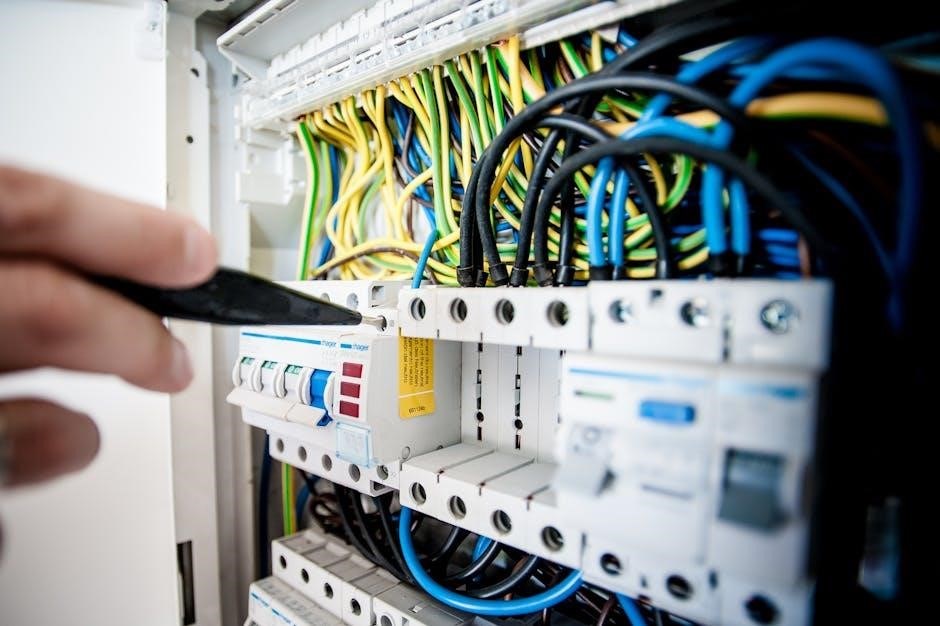bleeding hydraulic system on a ghs system pdf
Hydraulic systems require bleeding to remove air and fluid contamination, ensuring optimal performance and longevity, using a
specific procedure
on a GHS system, with safety precautions in place always.
Importance of Bleeding Hydraulic System
The importance of bleeding a hydraulic system cannot be overstated, as it plays a crucial role in maintaining the overall health and efficiency of the system. Hydraulic systems are designed to operate under high pressure, and the presence of air or fluid contamination can lead to a range of problems, including reduced performance, increased wear and tear, and even complete system failure. By bleeding the system, users can remove air and fluid contamination, ensuring that the system operates at optimal levels. This is particularly important for systems that are used in demanding applications, such as marine vessels, where reliability and performance are critical. Regular bleeding of the hydraulic system can help to prevent problems, reduce downtime, and extend the lifespan of the system. Additionally, bleeding the system can also help to identify any potential issues, allowing users to take corrective action before they become major problems. Overall, bleeding a hydraulic system is an essential maintenance task that should be performed regularly to ensure optimal performance and reliability.

Understanding the Hazards of Hydraulic Systems
Hazards include burns, bruises, and cuts from high-pressure fluid spray and flailing lines, posing significant risks to users and requiring caution and safety precautions always in place.
Types of Hazards Associated with Hydraulic Systems
Hydraulic systems pose various hazards, including thermal burns from hot fluid, physical injuries from high-pressure spray, and mechanical hazards from moving parts and flailing lines. The high pressure and temperature of hydraulic fluid can cause severe burns and injuries. Additionally, the sudden release of pressurized fluid can lead to physical injuries, such as bruises and cuts. Mechanical hazards, such as moving parts and flailing lines, can also cause injuries and fatalities. Furthermore, hydraulic systems can be prone to leaks and spills, which can lead to slips, trips, and falls. It is essential to identify and mitigate these hazards to ensure safe operation and maintenance of hydraulic systems. By understanding the types of hazards associated with hydraulic systems, users can take necessary precautions to prevent accidents and injuries. Regular maintenance and inspection of hydraulic systems can also help identify potential hazards and prevent them from occurring.

Safe Hydraulic System Performance Requirements
Regular maintenance and inspection are required for safe hydraulic system performance, using
proper procedures
to ensure optimal function and longevity always.
Precautions to Take Before Working on a Machine
Before working on a machine, it is essential to take necessary precautions to ensure safety and prevent accidents. This includes reading and understanding the machine’s manual, wearing personal protective equipment, and being aware of potential hazards.
Additionally, the machine should be turned off and the hydraulic system depressurized to prevent any unexpected movements or fluid leaks.
It is also crucial to ensure that the machine is properly supported and secured to prevent it from falling or collapsing, and to have a fire extinguisher nearby in case of emergencies.
By taking these precautions, workers can minimize the risk of injury and ensure a safe working environment.
Regular training and familiarization with the machine’s components and functions are also vital to prevent accidents and ensure efficient operation.
Moreover, workers should be aware of their physical limitations and not attempt to perform tasks that are beyond their capabilities, and should always follow established safety protocols.

GHS Hydraulic Platform Lift Systems
General Hydraulic Solutions manufactures lift systems for marine vessels, with a static load capacity of 700 pounds, using
hydraulic technology for efficient operation always.
General Hydraulic Solutions and Their Products
General Hydraulic Solutions is a company that specializes in the design and manufacture of hydraulic systems and components. Their products include hydraulic platform lift systems, which are designed to safely and efficiently lift and support heavy loads. These systems are commonly used in marine vessels, where they are used to lift and support swim platforms, tenders, and other equipment. The company’s products are known for their high quality and reliability, and are designed to meet the specific needs of their customers. General Hydraulic Solutions also offers a range of other products, including hydraulic cylinders, pumps, and valves, which are used in a variety of applications. The company’s goal is to provide its customers with the best possible products and services, and to help them to achieve their goals. By using the latest technology and manufacturing techniques, General Hydraulic Solutions is able to produce high-quality products that meet the needs of its customers.
Consequences of Air Trapped in a Hydraulic System
Air trapped causes spongy operation, cavitation, and system failure, affecting performance and longevity with
negative outcomes
always.
Effects of Air Trapped in a Hydraulic System on Performance
The presence of air in a hydraulic system can significantly impact its performance, leading to a range of problems including spongy operation, cavitation, and reduced system efficiency. This can result in decreased productivity, increased maintenance costs, and potentially even system failure. The effects of air trapped in a hydraulic system can be far-reaching, affecting not only the system itself but also the overall operation of the machine or equipment it is powering. In order to mitigate these effects, it is essential to properly bleed the system to remove any trapped air and ensure optimal performance. By doing so, operators can help to prevent damage, reduce downtime, and maintain the overall health and efficiency of the hydraulic system. Regular maintenance and inspection can also help to identify and address any issues related to air trapped in the system, allowing for prompt corrective action to be taken.

Step-by-Step Guide to Bleeding a Hydraulic System
Follow a sequential procedure to bleed the system, using
- ordered steps
to ensure all air is removed efficiently always.
Special Considerations for Vehicles with Angled Clutch Master Cylinders
Vehicles with angled clutch master cylinders require special attention when bleeding the hydraulic system, as the angle can cause air to become trapped, leading to spongy operation or complete system failure. The clutch master cylinder is typically mounted on an angle, with the end mounted to the firewall positioned higher than the line connection to the slave cylinder. This angle can make it difficult to remove air from the system, and specialized procedures may be necessary to ensure that all air is removed. A
- step-by-step approach
should be used to bleed the system, taking into account the unique characteristics of the angled clutch master cylinder. By following the correct procedure, it is possible to effectively bleed the hydraulic system and ensure optimal performance and longevity. The use of
- visual aids
and
reference materials
can also be helpful in understanding the process and identifying potential issues.
on the Importance of Bleeding Hydraulic Systems
The importance of bleeding hydraulic systems cannot be overstated, as it is crucial for maintaining optimal performance and longevity. A well-bled system ensures that all air is removed, preventing spongy operation, cavitation, and complete system failure. Regular bleeding also helps to prevent damage to system components, reducing the need for costly repairs and replacements. By following a
- step-by-step approach
to bleeding, individuals can ensure that their hydraulic system is functioning properly and safely. It is also essential to
reference manufacturer guidelines
and take necessary
- safety precautions
to avoid accidents and injuries. In conclusion, bleeding hydraulic systems is a critical maintenance task that should not be overlooked, and by prioritizing it, individuals can enjoy optimal system performance and extend its lifespan. Effective bleeding procedures can be found in various
technical resources
and should be consulted regularly to ensure compliance with industry standards.
